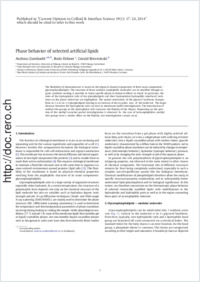Phase behavior of selected artificial lipids
- Zumbuehl, Andreas Department of Chemistry, University of Fribourg, Switzerland - Swiss National Centre of Competence in Research in Chemical Biology, Switzerland
- Dobner, Bodo Institute of Pharmacy, Martin Luther University of Halle-Wittenberg, Halle (Saale), Germany
- Brezesinski, Gerald Max Planck Institute of Colloids and Interfaces, Science, Potsdam, Germany
-
03.02.2014
Published in:
- Current Opinion in Colloid & Interface Science. - 2014, vol. 19, no. 1, p. 17–24
English
The flexibility of biomembranes is based on the physical-chemical properties of their main components - glycerophospholipids. The structure of these modular amphiphilic molecules can be modified through organic synthesis making it possible to study specific physical-chemical effects in detail. In particular, the roles of the hydrophobic tails of the phospholipids and their hydrophobic/hydrophilic interfacial backbone on the phase behaviour are highlighted. The spatial orientation of the glycerol backbone changes from sn-1,2 to sn-1,3 phospholipids leading to an increase of the in-plane area of the molecule. The larger distance between the hydrophobic tails can lead to membrane leaflet interdigitation. The introduction of methyl side groups in the hydrophobic tails increases the fluidity of the bilayer. Depending on the position of the methyl branches partial interdigitation is observed. In the case of bolaamphiphiles, methyl side groups have a similar effect on the fluidity, but interdigitation cannot occur.
- Faculty
- Faculté des sciences et de médecine
- Department
- Département de Chimie
- Language
-
- English
- Classification
- Chemistry
- License
-
License undefined
- Identifiers
-
- RERO DOC 260701
- DOI 10.1016/j.cocis.2014.01.003
- Persistent URL
- https://folia.unifr.ch/unifr/documents/304875
Statistics
Document views: 85
File downloads:
- pdf:: 271
